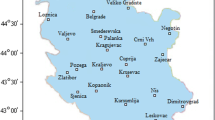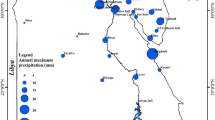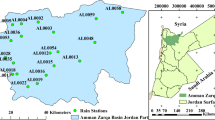Abstract
The main objective of this study is to determine the best fitting distribution to describe the annual series of maximum daily rainfall from 1975 to 2004 for 50 rain gauge stations in Peninsular Malaysia based on L-moment and LQ-moment. Five three-parameter extreme-value distributions which are considered are generalized extreme value (GEV), generalized Pareto (GP), generalized logistic (GL), lognormal (LN3) and Pearson (P3) distributions. The estimation of parameters of these distributions is determined using the L-moment and LQ-moment. The adequacy of the distributions based on parameter estimates computed using the two methods are evaluated using goodness-of-fit tests. When the goodness-of-fit results for these distributions are compared, it is found that, on the average, the performance of L-moment is better than the performance of LQ-moment. Although the best fitting distribution may vary according to the method of estimation and stations considered, in most cases, data for the majority of the stations are found to follow the generalized logistic distribution.



Similar content being viewed by others
References
Adamowski K, Bougadis J (2003) Detection of trends in annual extreme rainfall. Hydrol Proc 17:3547–3560
Aronica G, Cannarozzo M, Noto L (2002) Investigating the changes in extreme rainfall series recorded in an urbanised area. Water Sci Technol 45:49–54
Crisci A, Gozzini B, Meneguzzo F, Pagliara S, Maracchi G (2002) Extreme rainfall in a changing climate: regional analysis and hydrological implications in Tuscany. Hydrol Proc 16:1261–1274
Hosking JRM (1990) L-moments: analysis and estimation of distributions using linear combinations of order statistics. J R Stat Soc Ser, B 52(1):105–124
Hosking JRM, Wallis JR (1997) Regional frequency analysis: an approach based on L-moments. University press, Cambridge
Kotz S, Nadarajah S (2000) Extreme value distributions: theory and applications. Imperial College Press, London
Koutsoyiannis D (2003) On the appropriateness of the Gumbel distribution in modelling. Proceedings of the ESF LESC Exploratory Workshop, Bologna, Italy, 24–25 October 2003
Koutsoyiannis D, Baloutsos G (2000) Analysis of a long record of annual maximum rainfall in Athens, Greece, and design rainfall inferences. Nat Haz 22(1):31–51
Kysely J, Picek J (2007) Probability estimates of heavy precipitation events in a flood-prone central-European region with enhanced influence of Mediterranean cyclones. Adv Geosci 12:43–50
Mudholkar GS, Hutson AD (1998) LQ-Moments: analogs of L-Moments. J Stat Plan Inference 71:191–208
Nadarajah S, Choi D (2007) Maximum daily rainfall in South Korea. J Earth Sci 116(4):311–320
Nguyen VTV, Nguyen TD, Ashkar F (2002) Regional frequency analysis of extreme rainfalls. Water Sci Technol 45:75–81
Parida BP (1999) Modelling of Indian summer monsoon rainfall using a four-parameter Kappa distribution. Int J Climatol 19:1389–1398
Park JS, Jung HS (2002) Modelling Korean extreme rainfall using a Kappa distribution and maximum likelihood estimate. Theor Appl Climatol 72:55–64
Park JS, Jung HS, Kim RS, Oh JH (2001) Modelling summer extreme rainfall over the Korean peninsula using Wakeby distribution. Int J Climatol 21:1371–1384
Rakhecha PR, Soman MK (1994) Trends in the annual extreme rainfall events of 1 to 3 days duration over India. Theor Appl Climatol 48:227–237
Rao AR, Hamed HK (2000) Flood Frequency Analysis. CRC, Boca Raton, FL, USA
Vogel RM, Fennessey NM (1993) L-moment diagrams should replace product moment diagrams. Water Resour Res 29:1745–1752
Withers CS, Nadarajah S (2000) Evidence of trend in return levels for daily rainfall in New Zealand. J Hydrol (NZ) 39:155–166
Zalina MD, Desa MN, Nguyen VTV, Hashim MK (2002) Selecting a probability distribution for extreme rainfall series in Malaysia. Water Sci Technol 45:63–68
Acknowledgments
The authors are indebted to the staff of the Malaysia Meteorology Services for providing daily rainfall data to make this paper possible. This research would not have been possible without the sponsorship from the National University of Malaysia and Ministry of Higher Education, Malaysia. They also acknowledge their sincere appreciation to both reviewers for their valuable suggestions and remarks which improved the manuscript.
Author information
Authors and Affiliations
Corresponding author
Additional information
An erratum to this article can be found at http://dx.doi.org/10.1007/s00704-008-0076-7
Rights and permissions
About this article
Cite this article
Wan Zin, W.Z., Jemain, A.A. & Ibrahim, K. The best fitting distribution of annual maximum rainfall in Peninsular Malaysia based on methods of L-moment and LQ-moment. Theor Appl Climatol 96, 337–344 (2009). https://doi.org/10.1007/s00704-008-0044-2
Received:
Accepted:
Published:
Issue Date:
DOI: https://doi.org/10.1007/s00704-008-0044-2




